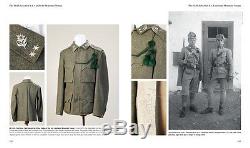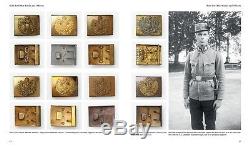The Austro-Hungarian Army WWI Uniforms & Equipment Book Massive Two Volume Set













"The Austro-Hungarian Army in the First World War Uniforms and Equipment from 1914 to 1918". Two volumes in a slipcase, 864 pages, more than 2500 colour photographs, contemporary BW-photographs and illustrations, bound in linen with a protective cover.
Format: 29.5 x 26.0 cm, ENGLISH TEXT. The assassination of the Austrian Heir Apparent, Franz Ferdinand, on 28 June 1914 provoked what is described by many historians as the Fundamental catastrophe of the 20th century. One of the armies that subsequently marched out in the hopes of a short war, was the Austro-Hungarian Army.
In the war years that followed, the soldiers of the k. Army would travel to almost all the First World Wars theatres of war. They fought in Galicia and Bukovina, in the Carpathian Mountains and the Balkans, from 1915 in the Southern Alps, on the Isonzo, in Albania and in the Sinai Desert and later on the German Western Front and in Asia. The war changed the k. Army, not only from a technical and a moral point of view, but also with regard to its appearance. The soldiers who marched out in 1914 presented a very different picture to that of the final years of the war. For the first time it has been possible, through painstakingly detailed work and with the use of extant documents in the Austrian State Archives as well as the extensive collections of the Heeresgeschichtliches Museum in Vienna, to create a comprehensive picture of the Austro-Hungarian uniforms during the First World War. Topics that are otherwise frequently neglected, like the volunteer motor corps, the medical corps, prisoners of war and projected uniforms for the post-war era, are also included in this documentation.This two-volume work, with 864 pages and over 2,000 reference book-quality colour photographs and 500 contemporary black and white photographs, presents a detailed overview of the uniforms and personal equipment of the soldiers of the Austro-Hungarian Army during the First World War. Volume 1 concentrates on the k.
Army caught in the field of tension created by the dualism of 1867 to 1914 and the development of their field uniforms before 1914. The pike grey field uniforms introduced for the k. Landwehr in 1907 and for the joint k.Landwehr in 1908 and the peculiarities of the cavalry, still dressed in their colourful uniforms at the beginning of the war, are dealt with in extensive chapters. These are followed by chapters on the field grey uniforms of 1915 in their various forms, wartime economy at a time when materials were becoming increasingly scarce, rank insignia and unit badges. It has also been possible to include photographs of the original official samples for many items of uniform.
Volume 2 deals with the personal items of equipment carried by the soldiers and the uniforms of special formations such as the motorised and aviation troops, tropical uniforms, field pastors and military bands, medical personnel and voluntary formations and legions. Belts, haversacks, canteens, knapsacks and gasmasks are all illustrated and described in detail. Photographs of the clothes worn by prisoners of war and the uniforms of the Volkswehr at the turn of 1919 are published here for the first time, completing this portrayal of the uniforms of the old Austro-Hungarian Army.One whole section is devoted to the Heir Apparent, Franz Ferdinand, and his assassination in Sarajevo. Eyewitness accounts describe the dramatic sequence of events on 28 June 1914. The uniform that Franz Ferdinand was wearing on the fateful day, which has been displayed in a glass case at the Heeresgeschichtliches Museum in Vienna since 1914, has been carefully photographed for this book, bearing witness to the tragic event that plunged the world into war in 1914. The item "The Austro-Hungarian Army WWI Uniforms & Equipment Book Massive Two Volume Set" is in sale since Monday, July 14, 2014. This item is in the category "Collectibles\Militaria\Other Militaria".
The seller is "kukarmee" and is located in Brookfield, Connecticut. This item can be shipped to United States.
- Country of Manufacture: Austria
- Type: Military Collectibles

